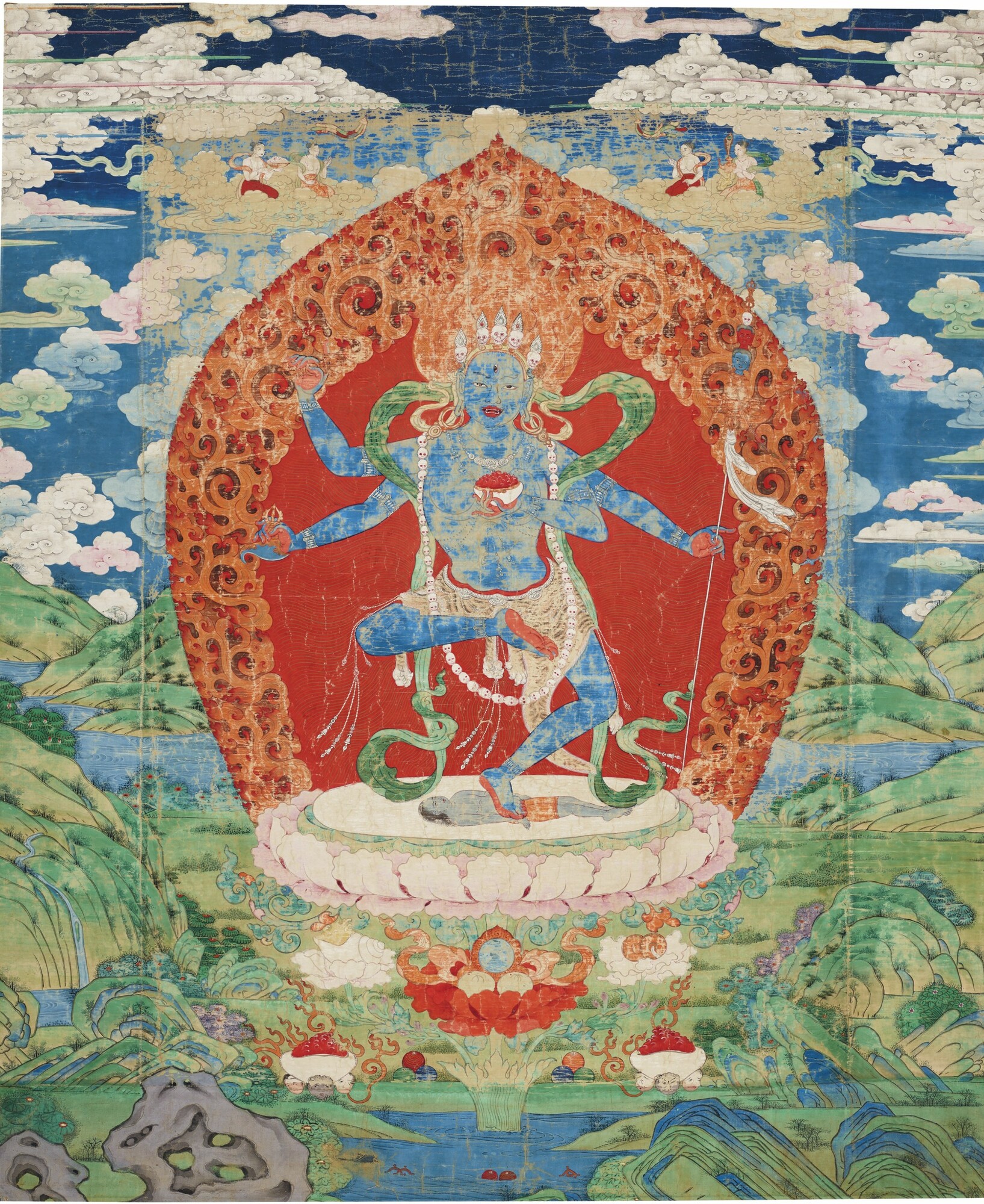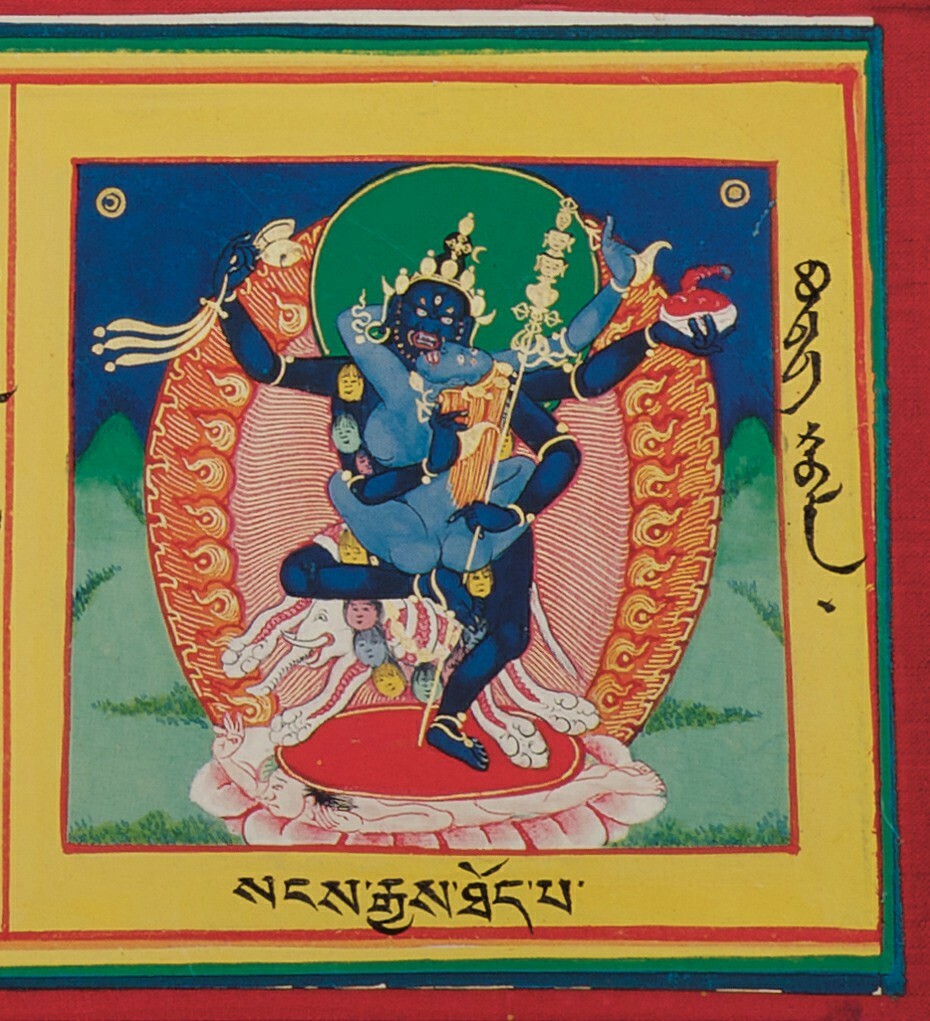Posted by Old Student (here)
I'm not sure either. I do know there was a similar belief about hitting the ground in falling dreams. I hit the ground in one, and then wondered where the story had come from and in investigating it, found out tons of people had, just like me, hit the ground and nothing had happened to them.
Same here.
It is one of the things that comes to mind in trying to relate to what you describe as corrections or adjustments, because it was just like seeing nothing happens--which for me it happened because I consciously released any Aversion or Fear.
That same attitude should pop a significant portion of many apparent barriers.
That is the same Siddhi as a Wrathful Bird Deity.Oops. I kicked the crows out. They were trashing the place and frightening the smaller birds. I (as the bird familiar of that shaman) told them to leave. They hang out across the street or next door. I didn't actually know that I had succeeded until they all stayed away, that's the first I found out they can somehow understand me.
If you can do that then you can use All-Purpose Khandaroha to deflect any Enemies.
In reality we had better be careful in trying to identify what the Enemy is.
In this case where such an enemy is invasiveness, and you have just effected a fence rather than harming them, that is like the intended role of Kila. But in the esoteric sense, you had better get a good Fence, the Cemeteries are outside it, and then if something comes crawling through, you Kila it.
How close is this to isotonic exercise?Sometimes the poses are 'extremes' they are the kind of limiting position of a particular kind of shaking and I stay in them for sometimes minutes (this kind usually have a lot of muscles at their maximum tension).
Some of this sounds like blazing and dripping. Mamaki is water related. Is Mahamaya, who in this passage seems like fire -- and therefore almost an opposite -- a complement?
It is interesting that earlier it is Nairatmya and later it is Varahi. I get the feeling that Varahi gradually accumulates things earlier ascribed to a larger set of deities.
Mamaki is Vastness of Vision who changes Elements and Families and the Arch Guhyesvari is multiple Families.
Perhaps I am jumping to conclusions since Mam can be three entities:
Manjushri
Mamaki
Marici
If there is reason to doubt she may be Manjushri, it could be possible it means Marici.
However the translation of a passage says:
She is manifested from a rope developed from the letter Maṃ (which is dark blue and whose rays are reddish) surrounded by the vowels and consonants on a moon disk, which was produced from the letter A on the origin of existences (dharmodaya, namely, the bhaga) placed at the center of a lotus of eight petals in a divine castle
that was developed from the letter Bhrūṃ on the summit of Mt. Sumeru. Mahāmāyā is dark-blue,
emits dark-blue fires, is of one face with three eyes and of four arms, makes her yellow hair stand on
end, is adorned with all good ornaments, wears a tiger skin on her waist, holds a rope, a hook, a bow
and an arrow, and stands in the shooting posture (g’yon brkyang gis bzhugs pa, *pratyālīḍhapada). He
visualizes eight goddesses standing in the same shooting posture on the eight petals of the lotus in a
divine castle. Then he keeps meditating them with the mantra "oṃ aṃ maṃ hūṃ."
Dark blue sounds less like Marici and Chapter Eleven describes itself as:
paramasiddhividyā mahāmāyā nāma mahāguhyeśvarī /
It tells you to meditate Vajrasattva, and then if we recall what his Vajri Bhava means, he relies on that to be Vajradaka, who is fused with dakinis. To do so, first Mahamaya comes, and she at first attracts Brahma and others, and then attracts White Four Face Vajradaka. And so her form from the original assures us the translator should not have said Rope but Noose:
ity āha bhagavān vajrī ◊ vajraḍākaḥ paraṃ sukham //17//
bhāvayed bhagamadhye tu ◊ sampūrṇacandramaṇḍalam /
tasya madhyagataṃ bījaṃ ◊ nīlāruṇasamaprabham //18//
nīlajvālākulā divyā ◊ nīlapaṅkajasaṃnibhā /
caturbhujā ekavaktrā ◊ trinetrā piṅgalordhvakeśajāe
//19//
sarvālaṃkārabhūṣitā ◊ vyāghracarmāvṛtā kaṭiḥ /
pāśāṅkuśadharā divyā ◊ dhanurbāṇākarṣaṇā parāe
//20//
indranīlasamāyuktam ◊ ādi-akṣarabhāvanā /
yasya vidyāṃ prayuñjīta ◊ kṣipram ānayate kṣaṇāt //21//
raktavarṇaṃ tato dhyātvā ◊ paścād dhyānaṃ vidadhītau /
Guhyeshvari is all three of those "Flames", Nairatma, Vajravarahi, and Mahamaya, but yes those are also codes for using the power to see different things.
Chapter Fifteen is Bhagavan Vajri Vajrasattva becoming Dakini Samayoga Paramasukha Vajradaka, and summarizes itself as:
iti kāyatrayodayamantratantrodayākālamṛtyuvañcano nāma paṭalaḥ pañcadaśamaḥ /
As if the whole thing was a part of Mrtyuvacana, not that she or it were optional or incidental.
It uses the "famous"
Rahasye Parame Ramye
to enact Mahamaya.
That is about all it says, although I am already a bit blurry what was in the other available chapters.
The Mahamaya Tantra is even further, except it is male Four Face Mahamaya who is a sex-changed Lakshmi who couples with the increased Vajravairocani, which is a second good reason to think of Vairocani as Source, because she is intended to increase into Buddhadakini and consort with Mahamaya.
Now if we could compound her across the whole Vajradaka, it would appear she is first taught as Akasha Dhatvishvari, before becoming Inner Fire:
Mahāmāyā (महामाया)or Padmaraśmī is the name of a deity associated with the Bhūta (element) named Ākāśa, according to the 9th century Vajraḍākatantra chapter 1.16-22.—Accordingly, this chapter proclaims the purity of the five components (skandha), five elements (bhūta) and five senses (āyatana) as divine beings [viz., Mahāmāyā].
That is the same pattern, from a conceptual teaching of Voidness, to a personal experience of Akash, which becomes Void Gnosis, which merges with Inner Fire.
She appears to be Mahesvari in a retinue for Mahakala:
To the East is Mahāmāyā (consort of Maheśvara), who stands in the ālīḍha attitude and rides a lion. She has four arms, of which the two left hands carry the kapāla and the ḍamaru, and the two right the kartri and the mudgara. She is blue in complexion, has dishevelled hair, three eyes and protruding teeth. All these deities are terrible in appearance, with protruding teeth and ornaments of serpents.
In Sadhanamala, Mahamaya is Maha Sarasvati, Varahi 221 is Guhyesvari and Mahamaya Mahesvari, and Mahamaya is also Cemetery Varahi and Jvalamukhi.
Maha Sarasvati is the one holding a flaming white lotus with her four special goddesses. It looks like a Medicine or Bhaisajya made from the sweet sound of Matta Kokila. Back to the birds.
Although Autumn Moon is perhaps common and is her origin here, it (Saradindu) is part of a famous Sloka that makes her a type of Pitha goddess and an aspect of Parabrahm:
Om Sri Gnana Saraswathi devathayai namaha,
śaradiṃdu samākāre parabrahma svarūpiṇe
vāsarā pīṭha nilaye sarasvatī namostute
That is about Blue Sarasvati; Maha Sarasvati is White.
The other ones have it as an epithet, whereas Sarasvati is the only one invoked mantricly by it, although as Mahamayange, suggesting she and her retinue are the "limbs" or portions of Maya. It is in conjunction with Hrih, perhaps suggesting this is Mahamaya compared to the Maya of Hrim.
Overall Mahamaya is a broad reaching name discussed in probably all philosophies, one of the most succinct being:
A vidyā taught to Pradyumna by Māyāvatī to vanquish Śambara; it was an astra and one which could dispel all māyā.
- Home
- Forum
- Chat
- Donate
- What's New?
-
Site Links

-
Avalon Library

-
External Sites

- Solari Report | Catherine Austin Fitts
- The Wall Will Fall | Vanessa Beeley
- Unsafe Space | Keri Smith
- Giza Death Star | Joseph P. Farrell
- The Last American Vagabond
- Caitlin Johnstone
- John Pilger
- Voltaire Network
- Suspicious Observers
- Peak Prosperity | Chris Martenson
- Dark Journalist
- The Black Vault
- Global Research | Michael Chossudovsky
- Corbett Report
- Infowars
- Natural News
- Ice Age Farmer
- Dr. Joseph Mercola
- Childrens Health Defense
- Geoengineering Watch | Dane Wigington
- Truthstream Media
- Unlimited Hangout | Whitney Webb
- Wikileaks index
- Vaccine Impact
- Eva Bartlett (In Gaza blog)
- Scott Ritter
- Redacted (Natalie & Clayton Morris)
- Judging Freedom (Andrew Napolitano)
- Alexander Mercouris
- The Duran
- Simplicius The Thinker





 Reply With Quote
Reply With Quote










Bookmarks